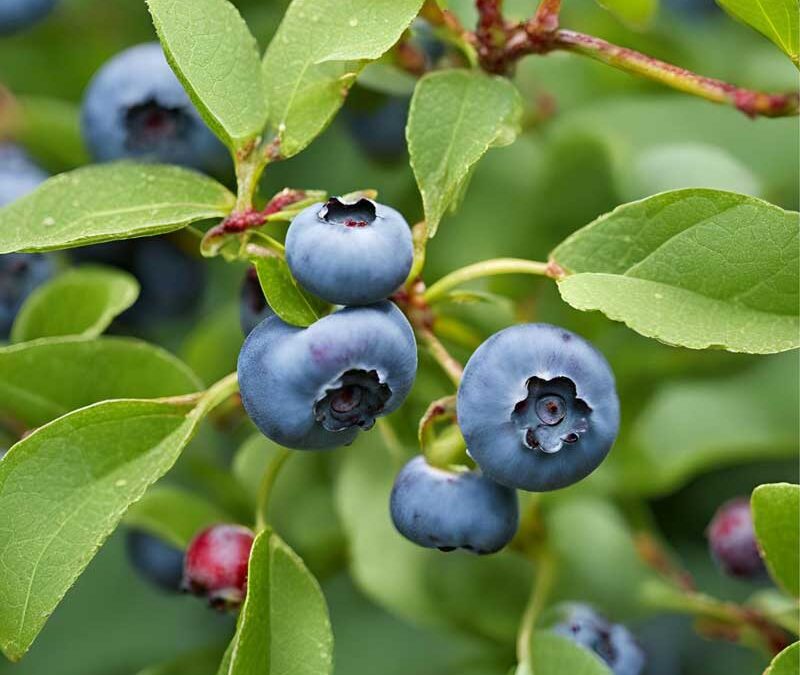Diving into the world of gardening, “Blueberry Companion Plants” stands out as a game-changer for those looking to enhance their berry patch. This guide unveils the secrets to pairing your blueberry bushes with the perfect plant allies, maximizing health, yield, and garden harmony. Discover how these companions can bolster your blueberries against pests, enrich the soil, and contribute to a thriving garden ecosystem. With the right knowledge and plant partners, your journey to bountiful blueberries is just a planting away.
Mastering Blueberry Care: Essentials for a Thriving Berry Garden
This section will guide you through the essentials of blueberry care, ensuring your bushes are healthy and productive.
Soil pH Mastery: Foundation for Healthy Blueberry Plants
To ensure your blueberry bush is in tip-top shape, let’s dive into its essential needs. First up is the soil pH; blueberries are all about that acidic life, thriving in soil with a pH range of 4.5 to 5.5. This acidic environment is where they hit their nutrient-absorbing stride, leading to lush growth and bountiful berry production.
Sunshine and Shade: Balancing Light for Optimal Blueberry Growth
Now, let’s talk sunlight. These berry plants are sun-lovers, requiring a solid six hours of full sunlight each day. This sunbathing helps them develop those delicious, juicy berries we all crave. When it comes to watering, think Goldilocks – not too much, not too little. Consistent moisture is key, as blueberries dislike both drought and soggy feet.
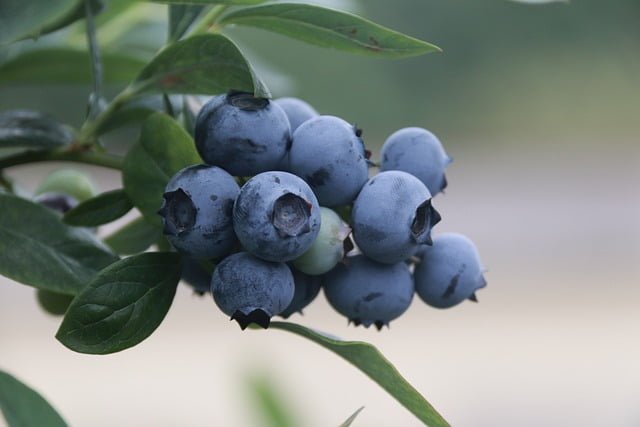
Fertilization Facts: Nourishing Your Blueberry Plants Right
Fertilization is next; blueberry plants don’t like to overindulge. They prefer specific fertilizers designed for acid-loving plants, ensuring they get the right balance of nutrients without overfeeding. Mulching is a fantastic way to keep their soil moist and acidic, also deterring those pesky weeds.
Protective Measures: Guarding Blueberry Plants Against Pests
Protection is crucial, too. Pesky critters and birds eyeing your berries? Use netting or bird scare tactics to keep them at bay. Lastly, don’t forget the annual haircut – pruning. This practice encourages new growth and fruit production, which is vital for a thriving blueberry bush.
The Best Companion Plants for Blueberries: Enhancing Your Garden Ecosystem
Companion planting with blueberries is a strategic approach to enhancing your garden’s ecosystem. Here’s how the best companion plants for blueberries can make a difference,
Herbs as Blueberry Companions
Heather
Heather acts as a natural ground cover, preventing weed growth and maintaining soil moisture around blueberry plants, which is essential for their care and development.

Thyme
Thyme, a great blueberry companion, helps protect your blueberry foliage from pests. It’s known for its ability to thrive in soil conditions similar to blueberries, enhancing the overall health and productivity of the blueberry area.
Chamomile
Chamomile, with its gentle flowers, attracts beneficial insects and promotes a healthy environment for blueberries to thrive. It’s often used in companion planting blueberries for its positive effects on nearby plants.
Mint
Mint, when planted with blueberries, acts as a ground cover around blueberry bushes, offering pest control benefits. However, avoid planting it too close as it can compete with blueberries for nutrients and water.
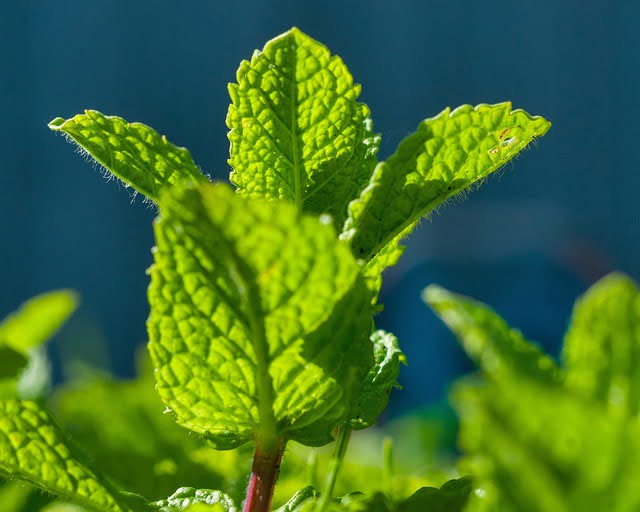
Sage
Sage, one of the best companion plants for blueberries, attracts pollinators that are essential for blueberry pollination and helps maintain the relationships between plants in the garden.
Gardenias
Gardenias, with their exquisite flowers, add aesthetic value and attract pollinators, benefiting the blueberry bushes in the vicinity.
Chives
Chives improve soil health and deter pests around blueberry bushes. They are considered good companions for blueberries due to their pest-repellent properties.
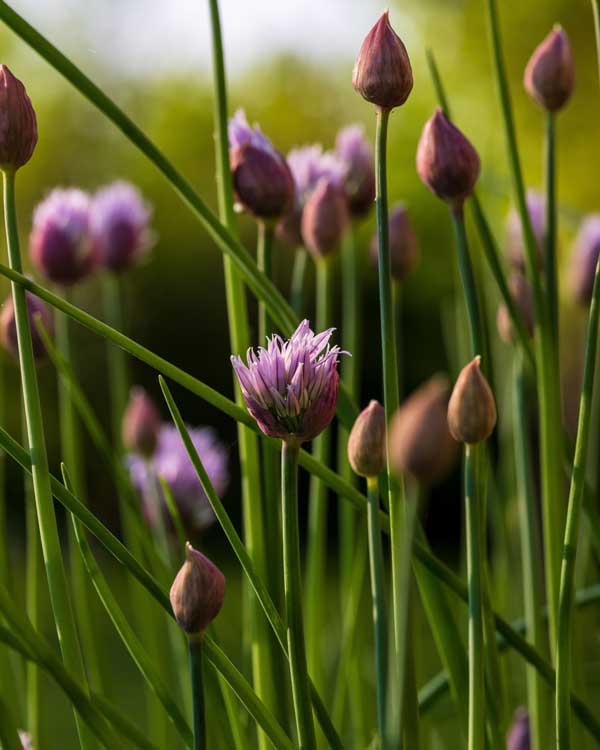
Parsley
Parsley, a perennial plant, attracts beneficial insects, contributing to the benefits of companion planting. It’s a suitable plant to grow alongside blueberries, enhancing the garden’s biodiversity.
Comfrey
Comfrey is known to improve soil quality and provide nutrients, making it one of the best companion plants for blueberries. It’s beneficial for both the blueberry plants and the surrounding garden area.
Lemon Balm
Lemon balm attracts beneficial insects, helping to maintain a healthy blueberry patch. Planting it near blueberries can enhance the garden’s overall ecosystem.
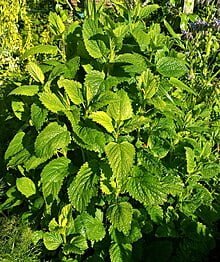
Borage
Borage, with its flower-rich nectar, attracts pollinators, aiding the blueberries to thrive. Its role in companion planting blueberries is vital for a fruitful harvest.
Ferns
Ferns provide a lush ground cover around blueberry bushes, helping to maintain soil moisture and protect the root system of the blueberry plants.
Azaleas and Rhododendrons
Azaleas and rhododendrons, with their vibrant blooms, not only beautify the garden but also support blueberry plants by attracting pollinators and maintaining acidic soil conditions.
Trillium
Trillium, when considering companion plants for blueberries, offers a natural woodland aesthetic and supports the local ecosystem, enhancing pollination for blueberry plants.

Acid-Loving Shrubs and Trees for Blueberry Enhancement
Holly
Holly can serve as a protective barrier and windbreak around your blueberry bushes, offering both aesthetic and practical benefits to the blueberry area.
Mountain Laurel
Mountain laurel complements blueberry bushes well, providing shade and aesthetic appeal without competing aggressively for nutrients.
Lilac
Lilac, with its fragrant flowers, is one of the best companion plants for blueberries, attracting pollinators and providing light shade to the blueberries during hot weather.
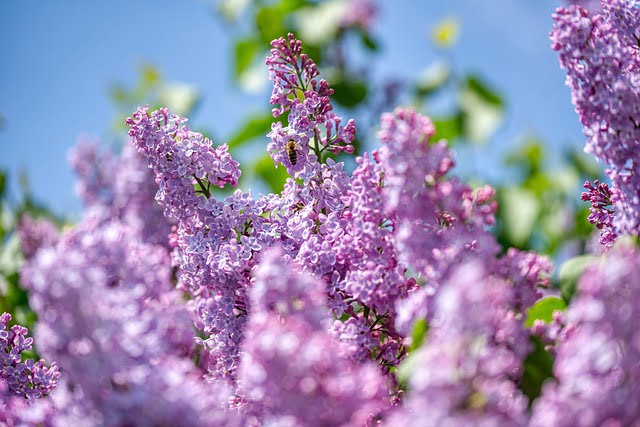
Pine Trees and Evergreens
Pine trees and evergreens like spruce and fir, known for thriving in acidic soil, offer shade and wind protection, making them great companions for blueberries in larger garden spaces.
Oak Trees
Oak trees create a stable environment, offering shade and protection. Their leaves help acidify the soil, favoring blueberry growth. Oaks also support diverse wildlife, including pollinators that benefit blueberry plants.
Birch Trees
Birch trees offer a light canopy, ensuring sufficient sunlight for blueberries. They help maintain the garden’s aesthetic and acidic soil conditions, while their ability to attract pollinators supports blueberry fruit set.
Maple Trees
Maple trees enhance the blueberry garden with their colorful leaves and provide shade, which is beneficial for blueberries. They also contribute to the acidic soil environment and attract pollinators, aiding blueberry production.

Ground Covers and Vegetables
Strawberries
Strawberries and blueberries complement each other well in the garden, with strawberries acting as an effective ground cover, suppressing weeds and maintaining soil moisture.
Beans
Beans, especially nitrogen-fixing varieties, enrich the soil, making them excellent companions for blueberries, aiding in nutrient uptake and soil fertility.
Clovers
Clovers, as ground cover around blueberry bushes, fix nitrogen in the soil and improve soil structure, which benefits the growth and health of blueberry plants.

Incorporating these plants in companion planting with blueberries not only supports the growth and productivity of the blueberry bushes but also enhances the overall health and aesthetic of the garden. These relationships between plants foster a balanced ecosystem where blueberries and their companions can flourish together.
Avoiding Pitfalls: What Not to Plant With Blueberries
Not all plants play well with blueberries. Some, like lavender and tomatoes, may actually hinder their growth. This section delves into the plants that should be kept away from your blueberry bushes to prevent competition for nutrients, unfavorable soil pH changes, and increased pest risks, ensuring your blueberries can thrive without hindrance.
Lavender
While lavender is loved for its fragrance and beauty, it’s not the best companion for blueberries. Lavender prefers more alkaline soil, which clashes with the acidic conditions blueberries require. When it comes to companion planting, it’s important to choose plants with similar soil requirements.
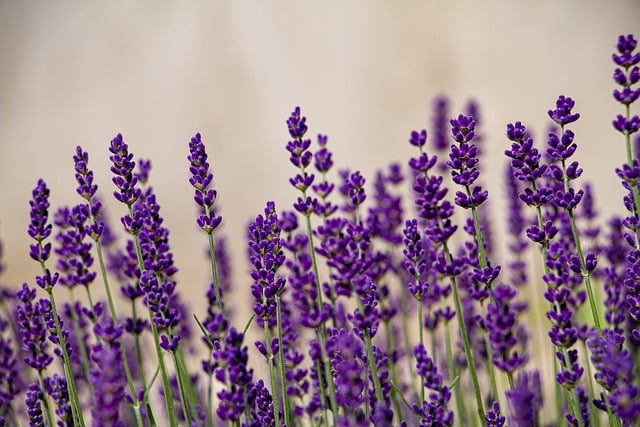
Tomatoes
Tomatoes, like blueberries, may share a love for the sun, but their soil pH preferences differ. Tomatoes thrive in slightly acidic to neutral soil, which doesn’t align with the more acidic needs of blueberries. This difference can make it challenging for both plants to perform well if planted too close to each other.
Potatoes
Potatoes are another crop that’s not ideal near blueberries. They prefer slightly acidic soil but can make blueberry care more difficult due to their different watering and nutrient needs. Plus, potatoes and blueberries can attract different pests and diseases, potentially increasing the risk to each other.
Eggplants and Peppers
Eggplants and peppers, belonging to the nightshade family like tomatoes, also prefer soil that’s less acidic than what blueberries thrive in. These plants might compete with blueberries for nutrients and water, not to mention they could attract pests that could harm blueberry bushes.
Cabbage, Broccoli, and Other Brassicas
Cabbage, broccoli, and other brassicas prefer neutral to slightly alkaline soil, quite the opposite of the acidic conditions beloved by blueberries. These heavy feeders can deplete the soil of nutrients blueberries need and alter the soil pH unfavourably for blueberry bushes.

When considering companion planting, it’s crucial to select the right plants that share soil and care requirements similar to blueberries. This ensures all plants, including blueberries, can thrive and produce bountiful harvests. Avoiding these incompatible plants will help maintain the health and productivity of your blueberry area, making your gardening efforts more rewarding.
Deep Dive into Blueberry Companion Planting: Strategies and Insights
Companion planting with blueberries is more than just placing plants next to each other; it’s about creating a thriving ecosystem where each plant benefits the others. Explore permaculture principles and learn how to strategically pair blueberries with companion plants in container gardens, maximizing the health and productivity of your gardening space
Permaculture Principles: Symbiotic Plant Relationships in the Blueberry Garden
Permaculture principles in the garden focus on creating sustainable and self-sufficient ecosystems where each element supports the others. When applying these principles to companion planting with blueberries, consider plants that contribute positively to the environment. For example, plants that provide mulch, like comfrey, can enrich the soil and retain moisture, benefiting blueberries. Nitrogen-fixing plants, such as beans or clovers, enhance soil fertility, aiding the growth of blueberry bushes. Furthermore, choosing plants that attract beneficial insects like ladybugs can naturally control pests, reducing the need for chemical interventions. This holistic approach not only helps your blueberries thrive but also promotes a balanced, healthy garden ecosystem.
Container Gardening: Compact Solutions for Growing Blueberries with Companions
Growing blueberries in pots is a fantastic option if space is limited or soil conditions are not ideal. When considering companion planting blueberries in containers, select herbs and edible plants that share similar soil and light preferences. For example, thyme and parsley can grow well in the same pots as blueberries, offering culinary benefits while attracting pollinators and controlling pests. This method allows for better management of soil conditions, ensuring that both blueberries and their companions thrive. Container gardening also facilitates easy relocation of plants to optimize sun exposure, enhancing the health and productivity of your blueberry plants.
In companion planting, choosing the right partners for your blueberries and understanding their mutual benefits can lead to a more fruitful and sustainable garden. Whether in the ground or pots, carefully selected companions can help create a thriving environment for your blueberry bushes, leading to a bountiful harvest and a healthy garden ecosystem.
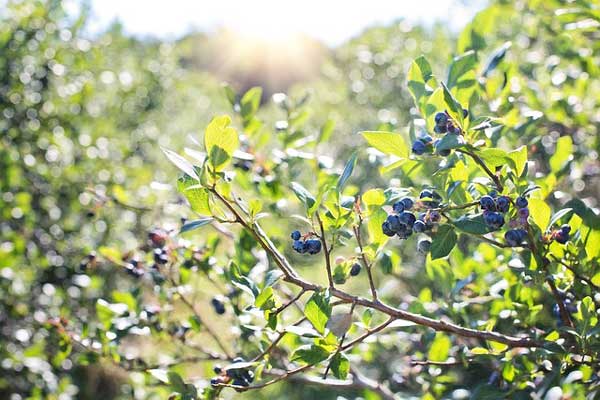
Advanced Blueberry Bush Care: Ensuring Plant Health and Berry Quality
Advanced care for blueberries involves meticulous attention to soil, water, and nutrient management. This section will provide you with the insights needed to prepare the ideal soil bed, implement effective watering and feeding strategies, and ensure your blueberries and their companion plants are at their best throughout the growing season.
Soil Preparation and Maintenance
For blueberries to flourish, maintaining the right soil conditions is key. These plants thrive in acidic soil, preferring a pH between 4.5 and 5.5. To achieve this, you may need to amend your garden soil. Materials like sulfur or peat moss can lower the soil pH, creating an ideal environment for blueberries and certain companion plants that prefer similar conditions. Testing the soil pH regularly helps keep track and make necessary adjustments. Ensuring the soil is well-aerated and rich in organic matter can also boost the growth and health of your blueberry bushes.
Watering and Feeding Insights
Blueberries require consistent moisture but dislike waterlogged conditions. Establishing a regular watering routine that keeps the soil moist but not soaked is essential for their well-being. When it comes to feeding, blueberries are light feeders and require specific types of fertilizers suitable for acid-loving plants. A balanced approach to fertilization, providing the nutrients needed without overdoing it, supports the robust growth of both the blueberries and their companion plants. Selecting the right plants to grow alongside your blueberries can help enhance nutrient uptake and ensure that all plants in your garden, including potential potted plants, receive the care they need to thrive.
In advanced care for blueberries and their companions, understanding the specific needs of these plants and how they interact with each other can lead to a successful, vibrant garden. With the right care, including soil management, watering, and feeding your blueberry bushes can produce bountiful crops and support the growth of surrounding companion plants.
The Bounty of Berries: Harvesting and Storing Tips for Your Blueberry Yield
The ultimate reward of growing blueberries is the harvest. Here, we’ll share tips on how to pick your blueberries at their peak perfection and store them properly to preserve their freshness and flavor, ensuring you can enjoy the fruits of your labor for longer.
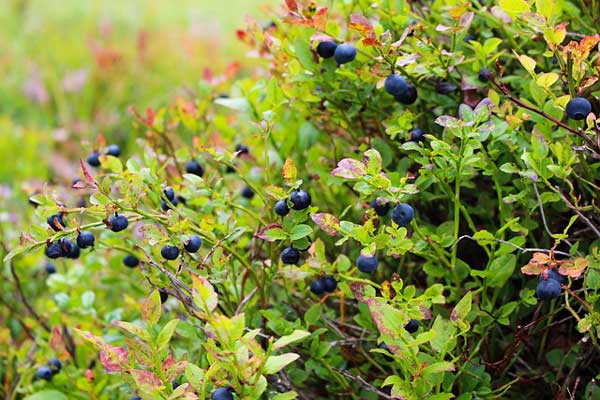
Harvesting Hints: Picking Blueberries at Peak Perfection
When it’s time to harvest, timing is everything to ensure you get the best and tastiest blueberries. Please wait until the berries are fully ripe, which is when they turn a deep blue color and detach easily from the bush. Gently roll the berries between your fingers; if they come off without resistance, they’re ready to pick. Harvesting in the cool of the morning can help keep the berries firm. Regular picking encourages the blueberry bushes to produce more fruit, optimizing your yield and ensuring that both the existing and new blueberries on the plant reach their full potential.
Storage Solutions: Preserving the Freshness of Your Blueberry Harvest
Once you’ve harvested your blueberries, proper storage is key to maintaining their freshness. Cool the berries as soon as possible after picking to preserve their flavor and extend their shelf life. Store them in a breathable container in the refrigerator to prevent moisture buildup, which can lead to spoilage. For long-term storage, blueberries can be frozen. Wash and dry them thoroughly, then spread them out on a baking sheet to freeze individually before transferring them to a freezer-safe container. This method prevents the berries from sticking together. It makes it easy to use the right amount for your needs, whether for a morning smoothie or a blueberry pie.
By following these harvesting and storage tips, you can enjoy the bounty of your blueberry bushes to the fullest. With the right techniques, you can savor the delicious taste of your home-grown blueberries long after the harvesting season has ended.
FAQ’s:
Q1: What are the best companion plants for blueberries?
A1: The best companion plants for blueberries include thyme, sage, and mint, which help deter pests and attract pollinators. Azaleas and rhododendrons are also excellent companions, thriving in acidic soil like blueberries and providing beautiful blooms to attract pollinators.
Q2: Are there any plants to avoid planting near blueberries?
A2: Yes, avoid planting lavender, tomatoes, and peppers near blueberries, as they have different soil pH requirements and can compete for nutrients. Brassicas like cabbage and broccoli should also be kept away, as they prefer more alkaline soil.
Q3: Can blueberries and blackberries be planted together?
A3: It’s best to plant blueberries and blackberries separately. Although they have similar berry family traits, they have different soil pH and nutrient requirements, which could lead to competition and potential growth issues.
Q4: How can permaculture principles be applied to blueberry companion planting?
A4: In permaculture, blueberry companion planting involves choosing plants that mutually benefit each other, like nitrogen-fixing plants to enrich the soil, ground cover plants to maintain moisture, and flowering plants to attract beneficial insects.
Q5: Can blueberries grow well in containers, and what are the best companion plants for them in pots?
A5: Blueberries can thrive in containers if their soil and sunlight needs are met. Herbs like thyme and parsley are good companions in pots because they don’t have invasive root systems and can coexist without competing for resources.
Q6: What are the benefits of companion planting with blueberries?
A6: Companion planting with blueberries can help improve soil health, reduce pests, attract pollinators, and enhance overall garden biodiversity, leading to healthier plants and better berry production.
By integrating these companion planting principles and considering the relationships between different plants, gardeners can create a harmonious environment that promotes the health and productivity of blueberries and their companions.
Conclusion
In conclusion, understanding the intricate dynamics between blueberry bushes and their companion plants can significantly enhance your garden’s productivity and health. By selecting the best companion plants, like certain herbs and flowers that thrive in similar conditions, gardeners can create a supportive environment that encourages blueberry plants to flourish. These companion plants not only enrich the soil and help maintain the right acidic conditions but also aid in pest control and attract beneficial pollinators.
Moreover, being mindful of the plants to avoid, such as those that compete with blueberries for nutrients or prefer different soil conditions, is crucial in ensuring your blueberries receive the care they need. Whether you have existing blueberry bushes or are planning to plant them next to new companions, understanding these relationships is key to a successful harvest.
Embracing the principles of companion planting and permaculture can lead to a thriving garden where blueberries and their companions grow well together, each contributing to the other’s success. With the right knowledge and care, your garden can become a bountiful and beautiful space, showcasing the harmony between blueberry varieties and their ideal plant partners.
For further exploration of gardening articles, kindly visit our webpage: Home Garden
Lemon Verbena Companion Plants
Companion planting with Asparagus

